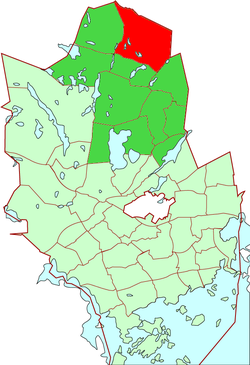
Helsinki is the capital and most populous city in Finland. It is located on the shore of the Gulf of Finland and serves as the seat of the Uusimaa region in southern Finland. Approximately 675,000 people live in the municipality, with 1.25 million in the capital region, and 1.58 million in the metropolitan area. As the most populous urban area in Finland, it is the country's most significant centre for politics, education, finance, culture, and research. Helsinki is situated 80 kilometres (50 mi) to the north of Tallinn, Estonia, 360 kilometres (220 mi) to the north of Riga, Latvia, 400 kilometres (250 mi) to the east of Stockholm, Sweden, and 300 kilometres (190 mi) to the west of Saint Petersburg, Russia. Helsinki has significant historical connections with these four cities.

Vantaa is a city in Finland. It is located to the north of the capital, Helsinki, in southern Uusimaa. The population of Vantaa is approximately 247,000. It is the 4th most populous municipality in Finland. Vantaa is part of the Helsinki Metropolitan Area, which has approximately 1.58 million inhabitants.

Espoo is a city in Finland. It is located to the west of the capital, Helsinki, in southern Uusimaa. The population of Espoo is approximately 314,000. It is the 2nd most populous municipality in Finland. Espoo is part of the Helsinki Metropolitan Area, which has approximately 1.58 million inhabitants.
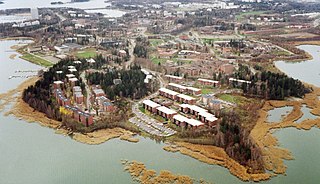
Otaniemi (Finnish), or Otnäs (Swedish), is a district of Espoo, Finland. It is located near the border of Helsinki, the capital of Finland.
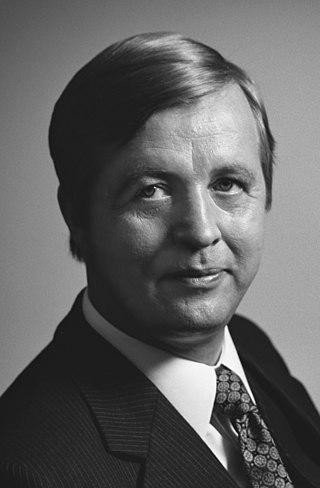
Taisto Kalevi Sorsa was a Finnish politician who served as Prime Minister of Finland three times: 1972–1975, 1977–1979 and 1982–1987. At the time of his death he still held the record for most days of incumbency as prime minister. He was also a long-time leader of the Social Democratic Party of Finland.
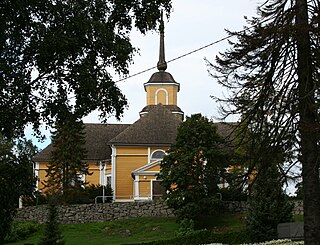
Nurmijärvi is a municipality in Finland, located in the southern interior of the country. Nurmijärvi is situated in the Uusimaa region. The population of Nurmijärvi is approximately 45,000. It is the 26th most populous municipality in Finland and the most populous municipality without city status. Nurmijärvi is part of the Helsinki metropolitan area, which has approximately 1.58 million inhabitants.
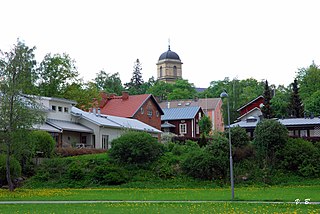
Vihti is a municipality in Finland, located in the southern interior of the country. Vihti is situated in the Uusimaa region. The population of Vihti is approximately 29,000. It is the 37th most populous municipality in Finland. Vihti is part of the Helsinki metropolitan area, which has approximately 1.58 million inhabitants.

Kiekko-Espoo Naiset are an ice hockey team in the Naisten Liiga. They play in the Tapiola district of Espoo, Finland at the harjoitusareena of the Tapiolan urheilupuisto. The team was founded as Espoon Kiekkoseura or EKS in 1989 and has also been known as Espoo Blues Naiset and Espoo United Naiset during its tenure in the Naisten Liiga. Kiekko-Espoo have won the Aurora Borealis Cup as the Finnish Champions in women's ice hockey sixteen times, six more wins than any other team in league history; at least one Finnish Championship medal was won under each of the four names.

Haukilahti is a neighbourhood in Espoo, Finland. It is located on the seashore of the Gulf of Finland in the southern part of the city.

Klaukkala is the southern-most urban area of the Nurmijärvi municipality in Uusimaa, Finland, located near Lake Valkjärvi. It is the largest urban area in Nurmijärvi, and despite the fact that it officially has the status of a village, it is often mistakenly thought to be a separate town due to its size and structure. In the 2010s, Klaukkala's urban area grew to be part of the larger Helsinki urban area.
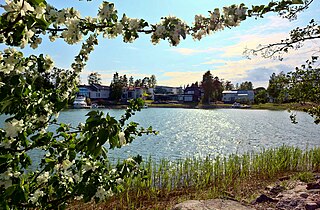
Westend is a district of the city of Espoo, Finland. It is located next to Tapiola and about ten kilometers from the center of Helsinki. From Westend Helsinki can be reached along Länsiväylä. Known as an affluent area, Westend is the wealthiest postal code area of Finland by mean household income. In 2019, the area was home to more than 3,000 residents.

Röykkä is a village located in the Nurmijärvi municipality of Finland, near the border of Vihti municipality. It is fourth largest village in the municipality after Klaukkala, Rajamäki and Nurmijärvi's church village. The population is about 1600.

Niittykumpu (Finnish) or Ängskulla (Swedish) is a district of Espoo, a city in Finland. The districts belongs to the major district of Suur-Tapiola. The district, partly located on the eastern lands of the former Gräsa manor, started developing along with the rest of southern Espoo in the 1930s when the street Jorvaksentie was completed. The first significant construction phase of Niittykumpu happened during the 1960s and 1970s, when a large number of terraced houses were built in the area because of rapid growth of the city of Espoo. Construction slowed down during the early 1990s depression in Finland. Construction picked up pace again in the 2000s and increased even further during the construction of the Länsimetro transport line.
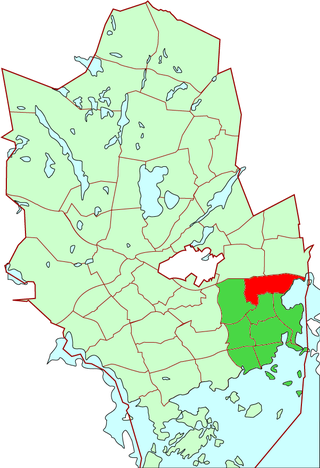
Laajalahti is a district of Espoo, a city in Finland. It belongs to the area of Suur-Tapiola together with Westend, Tapiola, Pohjois-Tapiola, Otaniemi, Niittykumpu, Mankkaa, and Haukilahti. It gets its name from the bay on which it is located. Laajalahti belongs to three sectors; Laajaranta, Lupauksenvuori, and Ruukinranta.

Espoonlahti (Finnish) or Esboviken (Swedish) is one of the five major urban areas of Espoo, a city in Finland. It lies along the south-western coast of Espoo, bounded to the west by the bay of the same name, to the south by the shores of the Gulf of Finland, to the west by the Finnoo (Finnå) valley, to the east of the municipal border of Kirkkonummi, and to the north by the forests of Espoo central forest area. This total area of about 4,800 hectares is further divided into areas called Soukka, Suvisaaristo, Kaitaa, Nöykkiö, Latokaski and Saunalahti, with one greater center called Espoonlahden keskus. Areas known as Laurinlahti, Ylä-Kivenlahti, Ala-Kivenlahti and Iivisniemi are also part of the Espoonlahti district. Yet another name pertinent to this area is Kanta-Espoonlahti, which includes Espoonlahden keskus, Soukanmäki, Kivenlahti, Laurinlahti and Soukanniemi.

Naisten Liiga, also called the Naisten SM-liiga (NSML) and Jääkiekon naisten SM-liiga, is the elite league for women's ice hockey in Finland. Founded by the Finnish Ice Hockey Association as the Naisten SM-sarja in 1982, it was so known until being rebranded as the Naisten Liiga in 2017. The league comprises approximately 250 players across ten teams.

Karl Emil Malmelin was a Finnish farmworker and mass murderer.

Harjula is a residential area of about 2,000 inhabitants in the southern part of Klaukkala in Nurmijärvi municipality, by the River Lepsämä and the road leading to Lahnus. There are spacious detached houses, terraced houses, small blocks of flats and some private services in the area. Harjula has an elementary school for about 250 students with grades 1–6, and kindergarten alongside of school. In the immediate vicinity of Harjula, in the direction of Klaukkala central, is the residential area called Syrjälä. Founded in 1976, the residents' association Harjula-Seura operates in Harjula.

Nurmijärven kirkonkylä is the administrative center of the Nurmijärvi municipality in Uusimaa, Finland. At the end of 2018, the population of the urban area, in accordance with Statistics Finland's agglomeration area, was 7,429 which made it the second most-populated urban area of the municipality after Klaukkala. It is located 8 kilometres (5.0 mi) from Rajamäki, 13 kilometres (8.1 mi) from Röykkä and 16 kilometres (9.9 mi) from Klaukkala.
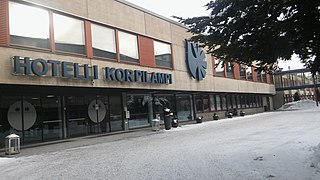
Hotel Korpilampi is a hotel in Lahnus, Espoo, Finland, operated by Pandox. Construction of this first so-called "wilderness hotel" in the Helsinki capital region started in 1975 and the hotel was opened in 1977. The hotel became publicly known in connection with the Korpilampi seminar in 1977. The hotel has a total of 156 rooms and 17 conference halls. The hotel also has a restaurant, a spa and a health club. Lomaliitto, the previous owner of Hotel Korpilampi, went bankrupt in 2009. After the bankruptcy the hotel was closed for a year and a half until Pandox bought the hotel.

